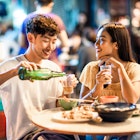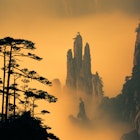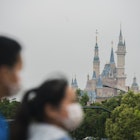

Red Chinese New Year lanterns and gold-coin decorations along Victoria Harbour © Gabrielle Chan / Shutterstock
On 16 February 2018, China marks a new year in the lunar calendar: the Year of the Dog, the 11th animal in the Chinese zodiac. Otherwise known as the spring festival, Chinese New Year is, for hard-working, hard-playing Hongkongers, a time to eat, drink, catch up with family and give red packets – lai see – stuffed full of money (and receive them, if you’ve been good).
In zinging Hong Kong style, the territory offers some of the most vibrant Chinese New Year celebrations that are easy for visitors to get involved in.

Here’s how best to celebrate Chinese New Year in Hong Kong and ensure good fortune for the year ahead. Kung hei fat choy!
Catch the Chinese New Year parade
Busy entertainment district Tsim Sha Tsui goes all out for Chinese New Year, covering every shopping centre and street in tinselly red baubles, paper cuts and pillar-box red lanterns. It’s on these buzzy shopping avenues that the Chinese New Year Night Parade takes place on the evening of Chinese New Year (from 6pm, 16 February 2018), with blinging floats and street performers marching through the streets to a loud Chinese drum beat.
Watch out for the much-loved traditional lion dance, where performers (usually trained martial artists) mimic the animal’s movements, using a fluffy puppet lion’s head and body, for good fortune.

Watch the Chinese New Year fireworks
In typical extravagant Hong Kong style, the free fireworks display over Victoria Harbour is the annual highlight of the Chinese New Year calendar. The 25-minute display coincides with the musical Symphony of Lights performance, which was revamped at the end of 2017 to include more buildings and more lasers.
Grab a front-row firework seat on the Tsim Sha Tsui Promenade in Kowloon, the Western District harbourfront in Sai Ying Pun or in Wan Chai’s Golden Bauhinia Sq. And don’t panic if you notice any particularly loud bits. It’s all part of the plan to scare away evil spirits for the upcoming year.
Editor's note: Hong Kong's 2018 fireworks display was cancelled as an expression of mourning for the victims of a bus crash in the city on 10 February.

Shop at the Victoria Park Flower Market
Hong Kong Island’s biggest public park, Victoria Park amplifies its flower power in the run-up to the Chinese New Year period (10-16 February 2018). Join thousands of other Hongkongers who are buying auspicious flowers and plants with which to decorate their homes during the spring festival.
What to buy? An orchid makes a beautiful gift (and a Confucian one – the Chinese philosopher was known to be partial to these flowers). Other festive flowers include water lilies (the flowers bloom around this time of year and they’re said to be lucky) or the unusual-looking kumquat and tangerine trees. Twisty bamboo shoots and cherry blossom branches are considered auspicious – and they look pretty. If you’re in Kowloon, the Fa Hui Park flower market in Sham Shui Po is another place to score some lucky blossoms.

Visit Wong Tai Sin Temple
Kowloon’s Sik Sik Yuen Wong Tai Sin Temple is one of Hong Kong’s biggest, busiest and most atmospheric temples, buried right in the middle of a residential housing estate. It commemorates a fourth-century Chinese monk that became a deity. Today, the temple is known for granting wishes (now you understand why it’s so busy!).
Chinese New Year is a particularly popular time to visit Wong Tai Sin, whether that’s to quietly pray or to loudly shake bamboo sticks that are then read by a fortune teller. Around 100,000 visitors usually descend on the temple during the holiday. Regardless of any wishes you want to make, it’s worth a visit to see its richly decorated setting and smell the pungent incense swirling in the air.

Eat auspicious foods
In a city that takes its cuisine seriously, it's no surprise that food is the cornerstone of Hong Kong's Chinese New Year celebrations.
There are a number of ‘lucky’ dishes eaten during the festival, so-named because their pronunciation sounds like something prosperous in Cantonese. For example, the humble lettuce (sang choi) is often eaten (and 'fed' to the lions during the lion dance) because it sounds similar to the phrase ‘growing wealth’. The pronunciation of oysters (ho see) sounds like ‘good business’; sticky rice cake, a Chinese New Year food that’s been eaten for over a millennia, sounds like ‘year high’. Then there's yee sang, a tossed raw-fish salad whose name is homophonous with abundance, and of course, black moss fungus – fat choi – is favoured during Chinese New Year because it sounds like ‘prosperity’ (this may sound familiar from the traditional new year greeting kung hei fat choy).
One celebratory food that is a staple of Chinese New Year parties is poon choi, a communal dish that has its origins in traditional villages in the New Territories, where meat and seafood are thrown together into a big wooden bowl and cooked up into a sort of stew.

Get down with the dogs
This year marks the Year of the Dog, and there are plenty of ways to celebrate man’s best friend. Hong Kong isn’t a particularly dog-friendly city (most beaches and parks don’t allow dogs to roam in them), but that doesn’t stop Hongkongers from dressing up their pooches in flamboyant costumes. During the Chinese New Year holiday, keep your eye out around the Central and Sheung Wan neighbourhoods for dogs trussed up in festive red (the season's auspicious colour) jackets, bowties and booties.
On Wan Chai’s cobbled Lee Tung Avenue, there’s a four-metre-high knotted sculpture of a dog, made using the ancient Chinese art form of knotting; while in almost every shopping mall there are dog motifs and paw prints everywhere.
There’s also plenty of festive pooch merchandise to get your hands on. The MTR Company is selling limited-edition Octopus transport cards adorned with dogs, as well as limited-edition souvenir tickets. Plus, the Hong Kong Post Office has launched a special dog-themed series of stamps – ideal to use sending home that postcard of the Victoria Harbour fireworks.
Explore related stories

Art and Culture
Halloween, Día de Muertos and more spooky festivals around the worldOct 19, 2023 • 5 min read







 Books"Places always surprise me" – Author Porochista Khakpour on traveling during historic moments
Books"Places always surprise me" – Author Porochista Khakpour on traveling during historic momentsMay 26, 2020 • 11 min read

